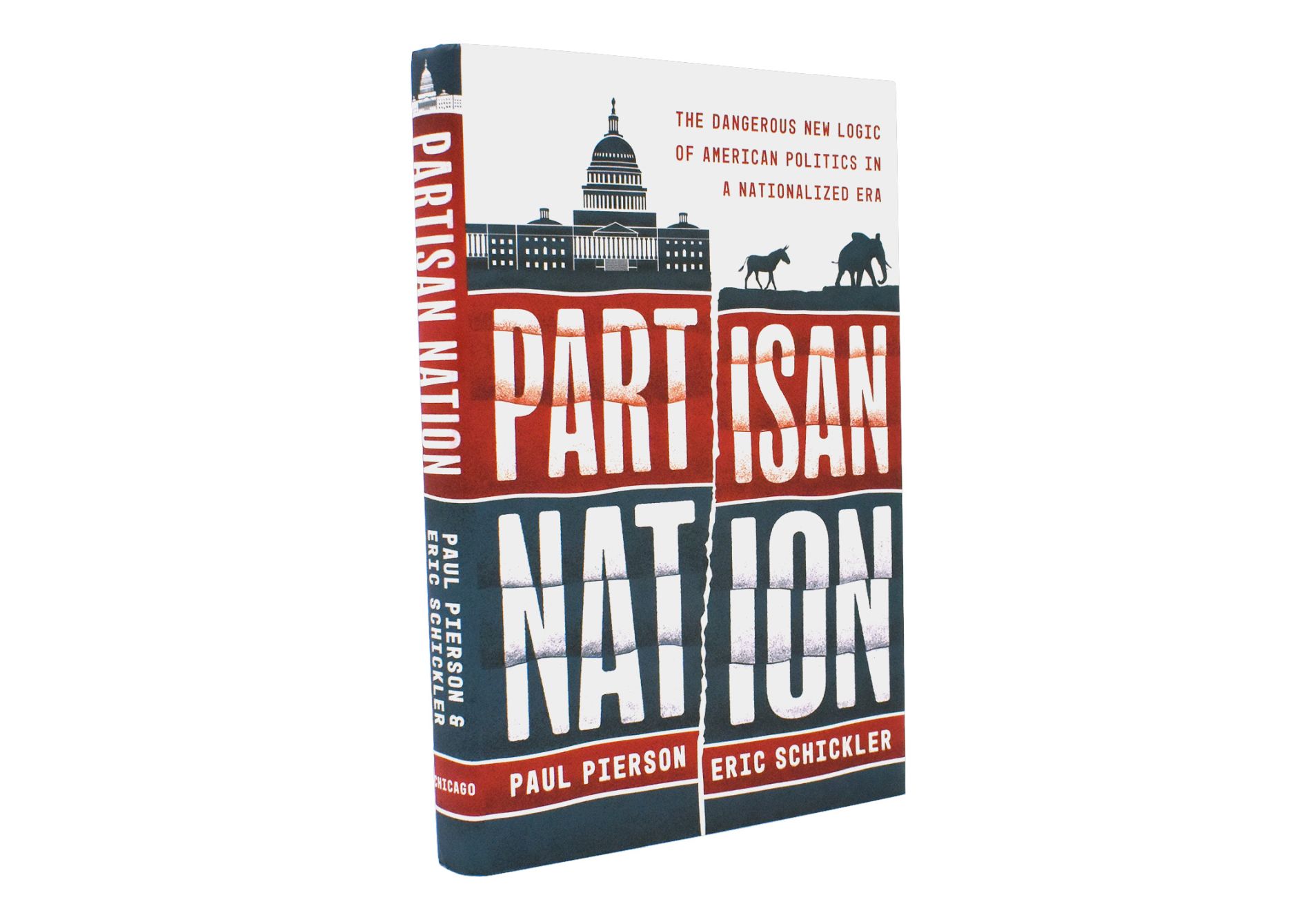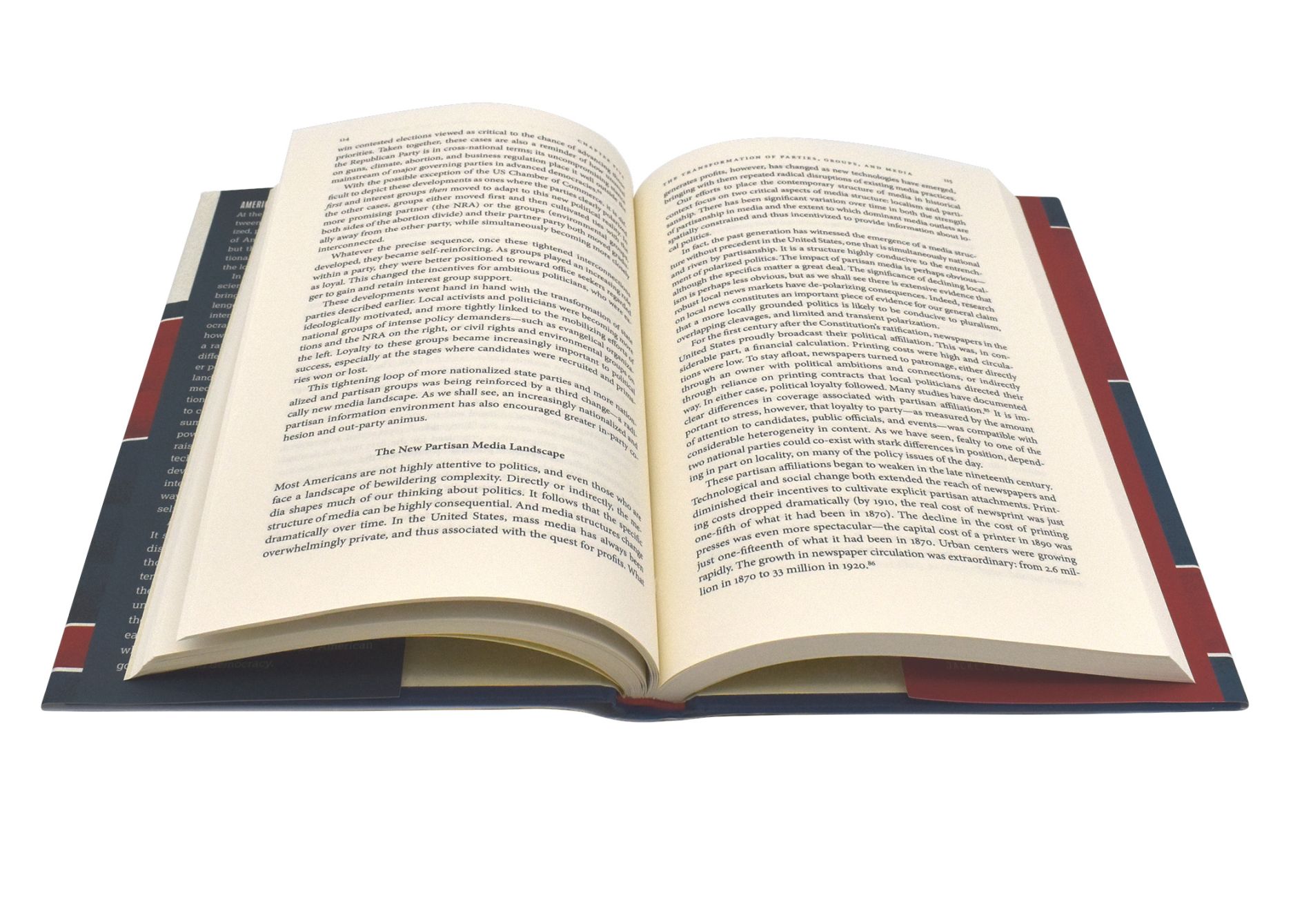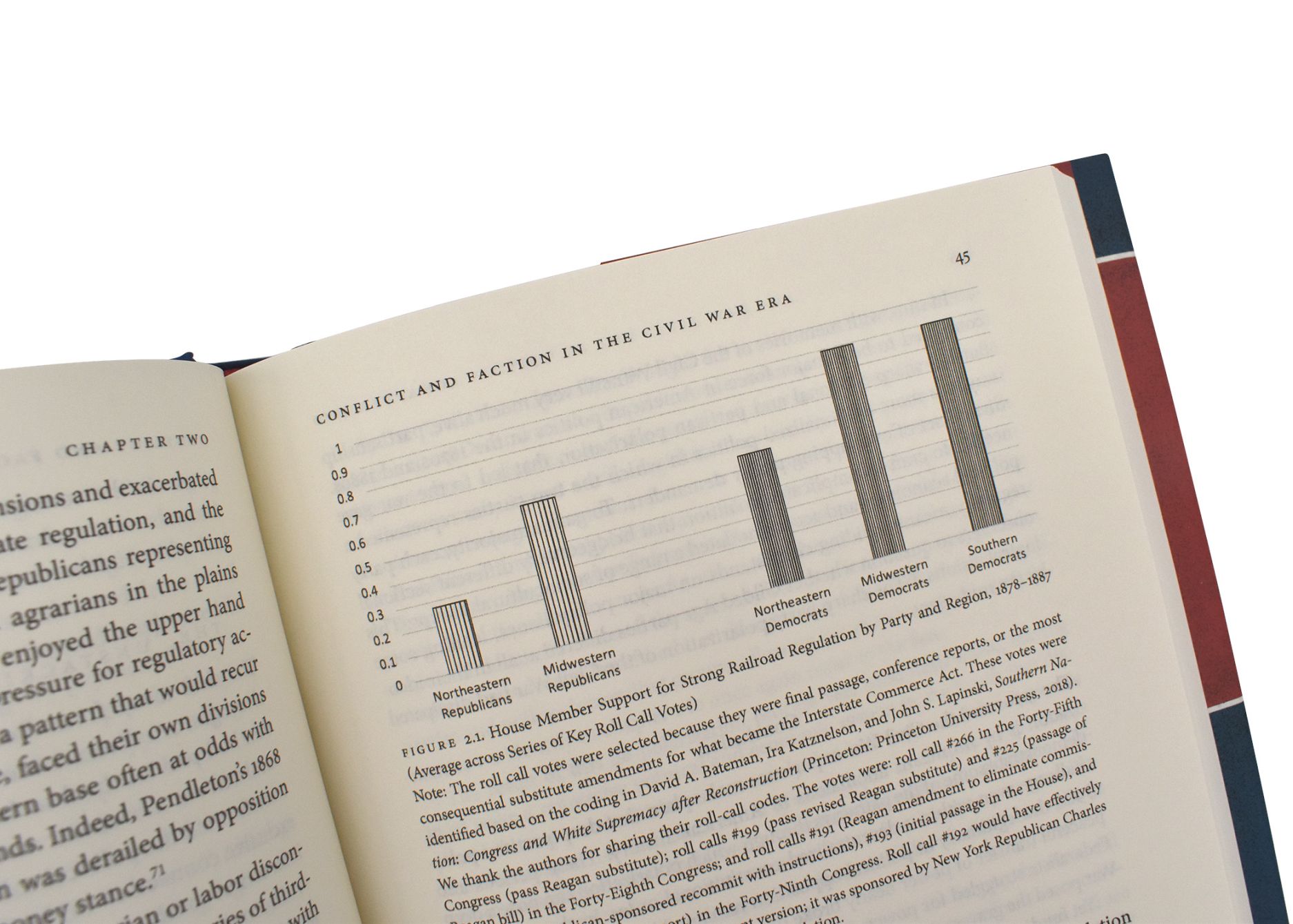Partisan Nation
The Dangerous New Logic of American Politics in a Nationalized Era
Partisan Nation
The Dangerous New Logic of American Politics in a Nationalized Era
A provocative exploration of how America’s democratic crisis is rooted in a dangerous mismatch between our Constitution and today’s nationalized, partisan politics.
The ground beneath American political institutions has moved, with national politics subsuming and transforming the local. As a result, American democracy is in trouble.
In this paradigm-shifting book, political scientists Paul Pierson and Eric Schickler bring a sharp new perspective to today’s challenges. Attentive to the different coalitions, interests, and incentives that define the Democratic and Republican parties, they show how contemporary polarization emerged in a rapidly nationalizing country and how it differs from polarization in past eras. In earlier periods, three key features of the political landscape—state parties, interest groups, and media—varied locally and reinforced the nation’s stark regional diversity. But this began to change in the 1960s as the two parties assumed clearer ideological identities and the power of the national government expanded, raising the stakes of conflict. Together with technological and economic change, these developments have reconfigured state parties, interest groups, and media in self-reinforcing ways. The result is that today’s polarization is self-perpetuating—and intensifying.
Partisan Nation offers a powerful caution. As a result of this polarization, America’s political system is distinctly and acutely vulnerable to an authoritarian movement emerging in the contemporary Republican Party, which has both the motive and the means to exploit America’s unusual Constitutional design. Combining the precision and acuity characteristic of their earlier work, Pierson and Schickler explain what these developments mean for American governance and democracy.
336 pages | 4 line drawings, 1 table | 6 x 9 | © 2024
Political Science: American Government and Politics
Reviews
Table of Contents
Part 1: Polarization in Historical Perspective
2. Conflict and Faction in the Early Republic and Civil War Era
3. Constrained Polarization at the Turn of the Century
Part 2: The Rise of Contemporary Polarization
4. Triggers of a Nationalized Partisanship
5. The Transformation of State Parties, Interest Groups, and Media
Part 3: The Crisis of the New American Constitutional Order
6. Policy by Other Means
7. Democracy in the Balance
8. What’s Next
Acknowledgments
Notes
Index
Excerpt
Democrats and Republicans may not agree on much, but for the past two decades, they have regularly shared one very important assumption: a victory by the other party’s candidates would constitute a grave threat to the future of their country. Some Republicans called 2016 the “Flight 93” election—implying that terrorists were flying the plane and it was time to storm the cockpit. Many Democrats viewed Donald Trump’s 2020 bid for reelection in similar terms. There have been elections in earlier eras where much the same could be said—but never before has there been such a long—and intensifying—run of presidential contests in which so many participants regarded the stakes as existential. This book aims to understand this critical transformation—and its implications for the future of the American political system.
Partisan rancor has become a defining feature of American politics. Growing numbers regard the other party with hostility and fear. Party elites are more polarized still. In Washington and many state capitals, politics has devolved into a zerosum conflict increasingly detached from longstanding norms and increasingly focused on sustaining partisan advantage. Moreover, party polarization has not simply endured; it has deepened. Aside from a brief post9/11 interlude, the intensity of these divisions has been building for more than four decades. Even such massive crises as the Great Recession of 2008–9 and the COVID19 pandemic of 2020–22 failed to disrupt it.
Political scientists and journalists have devoted enormous effort to understanding both the sources of partisan polarization and the many ways in which it shapes the daytoday behavior of ordinary citizens, election outcomes, and governance. But the intensity and durability of current divisions raise deeper questions. America’s constitutional system was not built for this. The Framers clearly hoped that the institutions they designed would prevent intense and durable partisan divisions, and political analysts long believed the Constitution had in fact become a solid bulwark against it. Today, however, we need to ask: Can our constitutional order function effectively amid this polarized politics? Can it even survive?
Polarization itself is not necessarily a threat to America’s constitutional democracy. American politics has been polarized in earlier periods, and core institutions emerged largely unscathed, or even strengthened, in its aftermath. Indeed, many commentators have drawn solace from these precedents.
But today’s polarization is quite distinctive. Precisely because it is different it has become selfreinforcing—increasingly difficult to dislodge and tending toward even greater intensification. Because today’s polarization is so different, it represents an unprecedented challenge to our constitutional system.
The nationalization of political conflict is at the heart of today’s dynamics. In past polarized eras, national parties operated within an altogether different political context. Key features—the character of state parties, the nature of group organizations and demands, and the structure of the press—acted as effective countervailing mechanisms against the risk of fierce and sustained polarization. Within a decentralized federal polity, these features created openings for major factional divisions, ultimately disrupting party lines. Repeatedly, the precise dynamic that James Madison famously expected the nation’s fragmented institutional structure to encourage emerged. Crosscutting cleavages limited both the intensity and durability of polarizing forces.
Today’s polarization, by contrast, has followed a different path. It emerged within a polity that was rapidly nationalizing, giving rise to new organizations and transforming existing ones. Nationalization created new relationships, balances of political power, and incentives. These changes, in turn, have further intensified divisions between the parties, their supporting coalitions, and voters. And the consolidation of this nationalized and polarized polity undercut many of the traditional sources of depolarization that worked in the past.
While we use the language of polarization it has an unfortunate limitation; it elicits images of symmetry. Speaking of polarization can be taken to imply that the two parties are mirror images of each other, that they have both moved equally—and in similar ways—away from centrism and moderation. Such a depiction may seem a useful simplification (and one that helpfully casts the observer in a seemingly neutral position). But it is simply false. Yes, the new context of nationalization has transformed both parties in some respects that are similar. Both coalitions have become more internally homogeneous and distinct from each other. Each faces growing incentives to operate as a team, both within and across the many venues of our politics. Both parties feel an increasing pull from their electoral base.
Yet the parties are not mirror images. They are different coalitions. They have different political aspirations. They have different political strengths and weaknesses—many of them powerfully shaped by the nation’s peculiar Constitution. Broad changes in American society, including dramatic changes in media and equally dramatic changes in the nation’s demographics, affect the two-party coalitions very differently.
The selfreinforcing dynamics we describe are particularly intense in the Republican Party, and these developments in the GOP are particularly damaging to the prospects for effective governance and democratic stability. They have encouraged Republican Party members and constituencies to support actions that escalate perceptions of partisan threat and endanger prior shared understandings of democratic governance. While the forces that would previously have counseled compromise and forbearance have weakened on the left, they have been eviscerated on the right.
In the chapters that follow, we elaborate on the sources of the stark asymmetry between the parties, focusing on differences in their coalitions, agendas, and media environments. A combination of unfavorable demographic change and a favorable skew of American political institutions (the Senate, the Supreme Court, and state legislative maps) present Republican elites with a particularly volatile combination of threat and opportunity. Republican politicians now face strong incentives to behave in ways that both impede governance and threaten the stability of American democracy. Critically, nationalized polarization has severely weakened the traditional institutional and electoral checks on such behavior. The Constitution was simply not designed to meet the challenges we now face. In fact, in many respects it magnifies vulnerabilities to dysfunctional governance and democratic backsliding. As this brief synopsis suggests, we ground our analysis in historical inquiry. We are by no means the first to use historical evidence to analyze contemporary polarization. Indeed, many studies of polarization begin with a simple graph charting congressional rollcall voting patterns over time to show that Democrats and Republicans have grown much further apart in their voting behavior in recent decades. These data demonstrate that contemporary divisions exceed even those in the late nineteenth century, which had until recently been viewed as the era with the deepest party polarization in American history. Many analysts concerned about the high level of polarization evident today have drawn comfort from their observation that polarization between the two parties, at least when it comes to voting in Congress, has been common in American history. If anything, the period of low polarization from the 1930s–70s was the anomaly. From this standpoint, worry about the intense divisions we observe today is overstated.
Yet these measures of polarization levels only take us so far. They reveal how differently Democrats and Republicans vote in Congress, but that does not tell us whether the parties are fighting about big or small policy issues, how far disagreement extends beyond the subjects of those rollcall votes, or the degree of animus between the parties. Democrats and Republicans can vote in diametrically opposed ways without viewing the other side as fundamentally illegitimate. Ideological “scores” do not tell us whether the strategies used by one or both parties seek to undermine basic democratic values. Put simply, these measures offer a picture of just one form of behavioral differences.
Others have turned to history as a source of analogies for today’s politics. The pitched battles between Jeffersonians and Federalists in the early years of the republic, the violent confrontations of the Civil War era, and the conflicts over industrial development and financial policy in the 1890s and early 1900s provide valuable lessons for what polarized politics look like in practice. Yet these comparisons are also limited in important ways. In particular, historical analogies tend to rely on the assumption that the political context was sufficiently similar across time. If, say, the emergence of a new, crosscutting issue undermined polarization in the past, one might expect something similar to happen now. In fact, we argue, the contexts are so different that these analogies are forced and misleading. Unfortunately, like measures of rollcall votes, simple reliance on historical analogies runs the risk of normalizing today’s political dynamics.
Our approach is different. We look at considerable stretches of time during periods identified as highly polarized, laying out the development of both polarization and subsequent depolarization. Adopting a “thicker” view of the relevant institutions that incorporate mass media, the organization of interests, and the structure of parties, we pay particular attention to the political mechanisms that have generally limited the scope and durability of polarization in these eras. These mechanisms, we argue, were based upon both the Constitution itself and a broader institutional context which once allowed decentralizing forces to flourish but no longer does. We draw a crucial distinction between the Constitution—the formal institutions of American government—and constitutional orders, which include both the Constitution and the nature of key mediating institutions.
We turn to history, in short, both to consider the rise and fall of polarization in prior eras and to make clear how different the contemporary challenge is from its predecessors. It is different because the constitutional order is different, even as the Constitution itself has remained essentially unchanged.
Our “thicker” view allows us to explore crucial differences between the con temporary parties, to deepen our understanding of the relationship between elite and masslevel politics, to clarify why contemporary polarization is so durable and intense, and to highlight poorly understood fragilities of the American political system.



